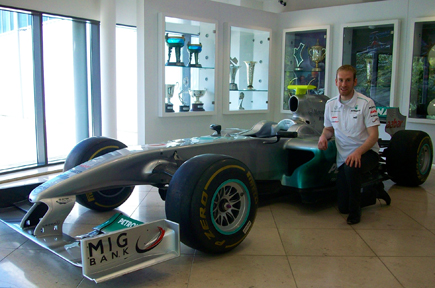
Alex Baer ’10 poses with a Mercedes AMG Petronas Formula One Team car from a previous year. The two blue cups at upper left are from the team’s victory in this year’s Chinese Grand Prix.
As a graduate powertrain integration engineer for the Mercedes AMG Petronas Formula One Team, Alex Baer ’10 works on all components “that the engine needs to run,” including water system and radiators, oil system and radiators, gearbox oil radiators, fuel system, and pneumatic system.
And that’s precisely where his dream, focus, and hard work have been aimed since as far back as he can remember.
“I’ve always been interested in cars and knew that I wanted to be an engineer,” says Baer. “I remember regular trips to the Ferrari dealership in Philadelphia. When I was 13 I met a man who lived near me who worked on Ferraris and other exotics. We became lifelong friends and through him I met many others who shared our interest.”
A mechanical engineering graduate, Baer won the Mechanical Engineering Design Award in 2010, completed a master of science in motorsports engineering at Cranfield University, and in October 2011 walked into a job at one of the most famous Formula One teams in the world—Williams, based in Grove, England, the Oxfordshire countryside where the majority of Formula One teams are located.
The Williams F1 team, the third most successful of all time, was established 35 years ago by Frank Williams. Baer says that this is an incredible accomplishment in the volatile Formula One environment in which there have been more than 100 teams over the past 60 years.
Baer was also a member of Lafayette’s 2010 Formula SAE car team, a project he sought when considering colleges. He attributes that experience as important to receiving the job offer from Williams F1.
“The mechanical engineering department at Lafayette is excellent and gave me a great foundation,” he says. “In addition, the machinists and technicians, especially Keith Moon, are incredible. They’re really helpful and great at what they do.”
At Williams, Baer was mechanical design engineer for gearboxes and a few other relevant systems. The team of about 400 includes mechanics, build technicians, lab technicians, machinists, engineers, and model designers.
F1 teams not only design a car every year, they also make constant improvements.
“Many aerodynamic parts will go through more than 25 revisions in a year,” explains Baer. “In Formula One, just to maintain your current pace relative to others you must constantly develop your car. If you stand still, you’ll move backwards. For reference, it is now July, the mid point in the season. At the beginning of the year the Ferrari team was over one second per lap slower than the fastest team. They are now the fastest team or second fastest. So this means they’ve gained more than a second as the others also improved. The rate of development is astonishing.”
In April, Baer joined the Mercedes AMG Petronas team in Brackley, England, in a special position designed especially for recently graduated engineers, which has given him the opportunity to work in a broad range of areas.
“The pneumatic system is used to operate the engine’s valves as traditional spring valves are not reliable at the F1 engine speeds—18,000 RPM,” he says. “My role is unique in that it is both analytical and design-oriented. From circuit to circuit, for example, the weather varies. Malaysia is hot and humid, Singapore is a dark night race, and England is wet and cool. So, the cooling system has different requirements through the season. It is adjusted to deliver maximum performance while still keeping the car cool. This is just one facet of hundreds that are adjusted.”
Baer had the opportunity to get to know Williams, whom he describes as “the most incredible man I have ever met.”
“One night as I was leaving work, I said goodnight as we passed in the hallway. He asked who I was and what I did. From my replies he noticed my accent and asked why I was ‘over here working in this town.’ I explained my lifelong passion for F1. He said he liked my dedication and invited me to come by his office one evening and we’d chat more. Needless to say I did so, and we talked about everything. He showed a genuine interest in how I was doing and how I was enjoying work.”

3 Comments
It is always inspiring to see Cranfield alumni succeed in the world of motorsport. Alex joins a list of alumni who work in Formula One. At the recent Singapore Grand Prix: Mercedes-AMG Petronas’ chief strategist, James Vowles, studied the same course as Alex; Lewis Hamilton’s race engineer, Mark Temple, also studied the MSc Motorsport Engineering and Management. Other Cranfield alumni included Mark Webber’s race engineer Ciaron Pilbeam. And behind the scenes there are many other graduates working for F1 teams and their suppliers. So if you have the academic ability and the determination to succeed as Alex has demonstrated we would welcome you applying to Cranfield.
Thanks for the info. There is nothing comparable to watching a live F1 race with the crowds.
Comments are closed.